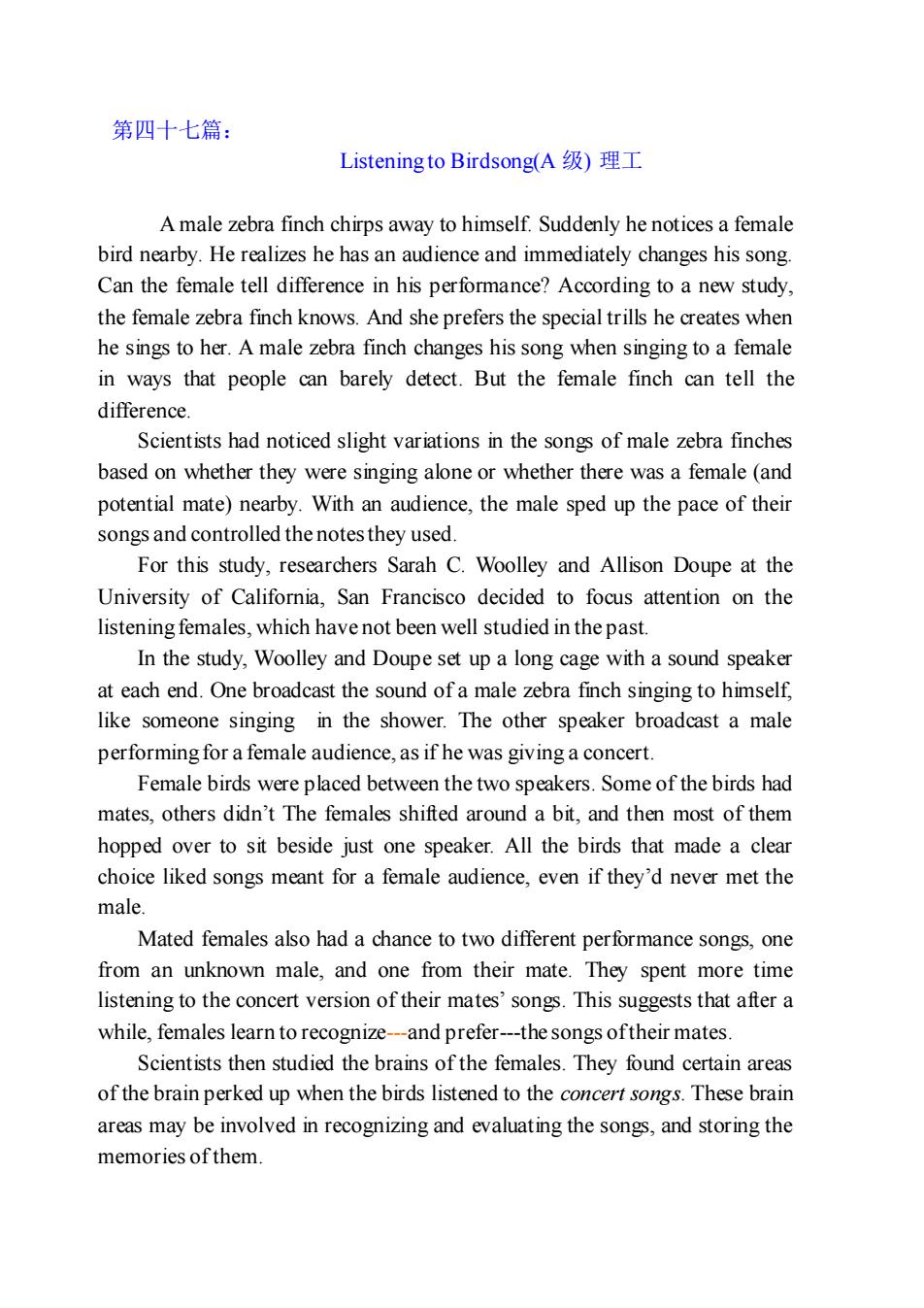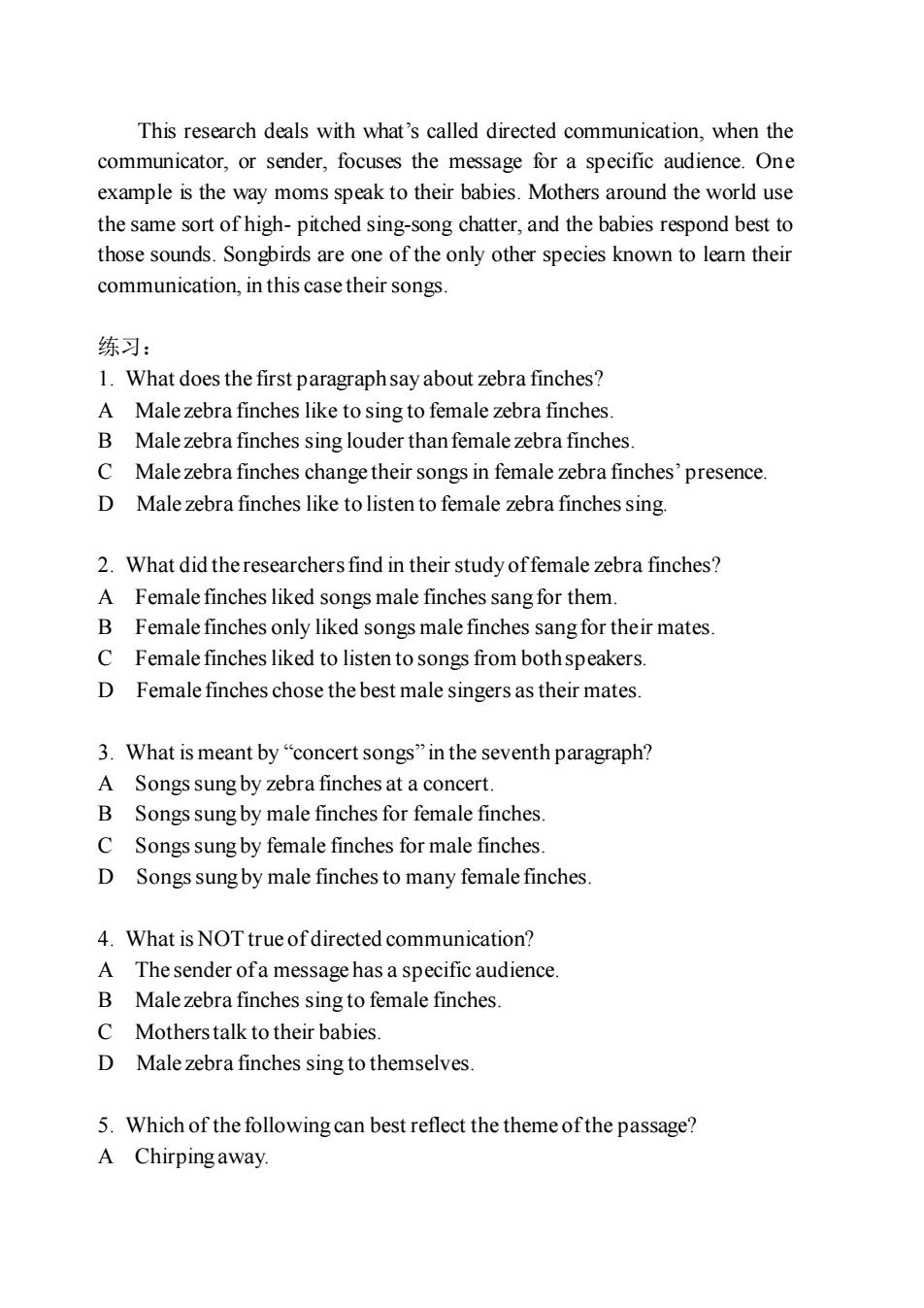
第四十七篇:Listeningto Birdsong(A级)理工A male zebra finch chirps away to himself. Suddenly he notices a femalebird nearby. He realizes he has an audience and immediately changes his songCan the female tell difference in his performance?According to a new study,the female zebra finch knows. And she prefers the special trills he creates whenhe sings to her. A male zebra finch changes his song when singing to a femalein ways that people can barely detect. But the female finch can tell thedifferenceScientists had noticed slight variations in the songs of male zebra finchesbased on whether they were singing alone or whether there was a female (andpotential mate) nearby. With an audience, the male sped up the pace of theirsongs and controlled the notes they used.For this study, researchers Sarah C. Woolley and Allison Doupe at theUniversity of California, San Francisco decided to focus attention on thelistening females, which have not been well studied in the past.In the study, Woolley and Doupe set up a long cage with a sound speakerat each end. One broadcast the sound of a male zebra finch singing to himself,like someone singing in the shower. The other speaker broadcast a maleperforming for a female audience, as if he was giving a concert.Female birds were placed between the two speakers. Some of the birds hadmates, others didn't The females shifted around a bit, and then most of themhopped over to sit beside just one speaker. All the birds that made a clearchoice liked songs meant for a female audience, even if they'd never met themale.Matedfemales alsohadachancetotwodifferentperformance songs,onefrom an unknown male, and one from their mate. They spent more timelistening to the concert version of their mates' songs. This suggests that after awhile, females learn to recognize---and prefer---the songs oftheir mates.Scientists then studied the brains of the females. They found certain areasof the brainperked up when the birds listened to the concert songs.These brainareas may be involved in recognizing and evaluating the songs, and storing thememoriesofthem
第四十七篇: Listening to Birdsong(A 级) 理工 A male zebra finch chirps away to himself. Suddenly he notices a female bird nearby. He realizes he has an audience and immediately changes his song. Can the female tell difference in his performance? According to a new study, the female zebra finch knows. And she prefers the special trills he creates when he sings to her. A male zebra finch changes his song when singing to a female in ways that people can barely detect. But the female finch can tell the difference. Scientists had noticed slight variations in the songs of male zebra finches based on whether they were singing alone or whether there was a female (and potential mate) nearby. With an audience, the male sped up the pace of their songs and controlled the notes they used. For this study, researchers Sarah C. Woolley and Allison Doupe at the University of California, San Francisco decided to focus attention on the listening females, which have not been well studied in the past. In the study, Woolley and Doupe set up a long cage with a sound speaker at each end. One broadcast the sound of a male zebra finch singing to himself, like someone singing in the shower. The other speaker broadcast a male performing for a female audience, as if he was giving a concert. Female birds were placed between the two speakers. Some of the birds had mates, others didn’t The females shifted around a bit, and then most of them hopped over to sit beside just one speaker. All the birds that made a clear choice liked songs meant for a female audience, even if they’d never met the male. Mated females also had a chance to two different performance songs, one from an unknown male, and one from their mate. They spent more time listening to the concert version of their mates’ songs. This suggests that after a while, females learn to recognize-and prefer-the songs of their mates. Scientists then studied the brains of the females. They found certain areas of the brain perked up when the birds listened to the concert songs. These brain areas may be involved in recognizing and evaluating the songs, and storing the memories of them

This research deals with what's called directed communication, when thecommunicator, or sender, focuses the message for a specific audience. Oneexample is the way moms speak to their babies. Mothers around the world usethe same sort of high-pitched sing-song chatter, and the babies respond best tothose sounds. Songbirds are one of the only other species known to learn theircommunication, inthiscasetheir songs.练习:1. What does the first paragraph say about zebra finches?AMalezebrafinches liketosingtofemalezebrafinchesBMalezebrafinches singlouderthanfemalezebrafinchesCMalezebrafinches changetheir songs infemalezebrafinches'presence.DMale zebra finches like to listen to female zebra finches sing.2.What didtheresearchers find in their studyoffemale zebra finches?AFemale finches liked songs male finches sang for them.BFemalefinches onlyliked songsmalefinches sangfortheirmatesCFemalefincheslikedtolistentosongsfrombothspeakersDFemalefinches chose the best male singers as their mates.3. What is meant by “concert songs" in the seventh paragraph?Songs sung by zebra finches at a concert.ABSongssungbymalefinchesforfemalefinches.CSongs sung by female finches for malefinchesDSongs sungbymalefinchestomanyfemalefinches4.WhatisNOTtrueofdirected communication?AThe sender ofa message has a specific audience.B Male zebra finches sing to female finches.Motherstalktotheirbabies.CD Malezebrafinches singtothemselves5. Which of the following can best reflect the theme ofthe passage?AChirpingaway
This research deals with what’s called directed communication, when the communicator, or sender, focuses the message for a specific audience. One example is the way moms speak to their babies. Mothers around the world use the same sort of high- pitched sing-song chatter, and the babies respond best to those sounds. Songbirds are one of the only other species known to learn their communication, in this case their songs. 练习: 1. What does the first paragraph say about zebra finches? A Male zebra finches like to sing to female zebra finches. B Male zebra finches sing louder than female zebra finches. C Male zebra finches change their songs in female zebra finches’ presence. D Male zebra finches like to listen to female zebra finches sing. 2. What did the researchers find in their study of female zebra finches? A Female finches liked songs male finches sang for them. B Female finches only liked songs male finches sang for their mates. C Female finches liked to listen to songs from both speakers. D Female finches chose the best male singers as their mates. 3. What is meant by “concert songs” in the seventh paragraph? A Songs sung by zebra finches at a concert. B Songs sung by male finches for female finches. C Songs sung by female finches for male finches. D Songs sung by male finches to many female finches. 4. What is NOT true of directed communication? A The sender of a message has a specific audience. B Male zebra finches sing to female finches. C Mothers talk to their babies. D Male zebra finches sing to themselves. 5. Which of the following can best reflect the theme of the passage? A Chirping away

BBirdsongsascommunicationC Zebra finches andtheir lifeD Enjoyingbirdsongs.答案:1.C2.A3.B4.D5.B第四十七篇:倾听鸟鸣一只雄性斑胸草雀对着自已岐嗜而鸣。突然间,他注意到不远处有一只雌性斑胸草雀。他意识到自己有一位听众并立即改变了自己的声调。那只雌性斑胸草雀能发现他的不同吗?根据一项新的研究结果显示,答案是可以的,并且那只雌性斑胸草雀更喜欢当雄性斑胸草雀为她歌唱时所制造的特殊颤音。人类很难发觉雄性斑胸草雀对着雌性斑胸草雀鸣叫时所做出的改变,但是雌性胸斑草雀可以发现其中的不同。科学家们根据雄性斑胸草雀是否在独自歌唱或者根据其周围是否有一只雌性斑胸草雀(潜在配偶)在场,发现了他们歌声中的略微不同。当有听众在场的时候,雄性斑胸草雀就会加快他们鸣叫的速度并且控制其所用的鸣音。为了此项研究,加州大学旧金山分校的两位研究员:萨拉.C.伍利和艾莉森杜普决定关注倾听者一一雌性斑胸草雀,而雌性斑胸草雀在过去并没有被仔细研究过。在研究中,伍利和杆普建了一个很长的笼子,笼子两边分别装有一个扬声器。其中一边播放的是雄性斑胸草雀对着自已演唱时所发生的鸣叫声,好似一个人在洗澡时所唱的歌。另一边播放的则是雄性斑胸草雀向另一只雌性观众表演时的所发出的鸣叫声,仿佛他是在举行一场音乐会。雌鸟被放置在两个杨声器之间。这些雌鸟中有的已经有了配偶,有的还没有。她们崔了一会,便大多飞向并暂栖在了其中的一个扬声器旁边。所有的鸟都选择了为了雌鸟而发出的表演性鸣叫声,即使她们从未见过那只发音的雄性胸斑草雀。有了配偶的雌性胸斑草雀还可以听到两个不同的表演性鸣叫声,其中一个来自未知的雄鸟,另一个则来自她们的配偶。她们花了更多的时间倾听自己配偶的歌声。而这表明雌鸟在经过一段时间后可以识别出并且更加喜爱自己配偶的歌声。科学家们继而研究了雌鸟的脑部。他们发现雌鸟听到表演性鸣叫的时候,这些鸟的脑部特定区域会变得活跃起来。而这些区域可能同识别,评价和储存歌声有关
B Birdsongs as communication. C Zebra finches and their life. D Enjoying birdsongs. 答案:1.C 2.A 3.B 4.D 5.B 第四十七篇: 倾听鸟鸣 一只雄性斑胸草雀对着自己吱喳而鸣。突然间,他注意到不远处有一只雌 性斑胸草雀。他意识到自己有一位听众并立即改变了自己的声调。那只雌性斑胸 草雀能发现他的不同吗?根据一项新的研究结果显示,答案是可以的,并且那只 雌性斑胸草雀更喜欢当雄性斑胸草雀为她歌唱时所制造的特殊颤音。人类很难发 觉雄性斑胸草雀对着雌性斑胸草雀鸣叫时所做出的改变,但是雌性胸斑草雀可以 发现其中的不同。 科学家们根据雄性斑胸草雀是否在独自歌唱或者根据其周围是否有一只雌 性斑胸草雀(潜在配偶)在场,发现了他们歌声中的略微不同。当有听众在场的 时候,雄性斑胸草雀就会加快他们鸣叫的速度并且控制其所用的鸣音。 为了此项研究,加州大学旧金山分校的两位研究员:萨拉.C.伍利和艾莉森. 杜普决定关注倾听者—— 雌性斑胸草雀,而雌性斑胸草雀在过去并没有被仔细 研究过。 在研究中,伍利和杜普建了一个很长的笼子,笼子两边分别装有一个扬声器。 其中一边播放的是雄性斑胸草雀对着自己演唱时所发生的鸣叫声,好似一个人在 洗澡时所唱的歌。另一边播放的则是雄性斑胸草雀向另一只雌性观众表演时的所 发出的鸣叫声,仿佛他是在举行一场音乐会。 雌鸟被放置在两个扬声器之间。这些雌鸟中有的已经有了配偶,有的还没有。 她们徘徊了一会,便大多飞向并暂栖在了其中的一个扬声器旁边。所有的鸟都选 择了为了雌鸟而发出的表演性鸣叫声,即使她们从未见过那只发音的雄性胸斑草 雀。 有了配偶的雌性胸斑草雀还可以听到两个不同的表演性鸣叫声,其中一个来 自未知的雄鸟,另一个则来自她们的配偶。她们花了更多的时间倾听自己配偶的 歌声。而这表明雌鸟在经过一段时间后可以识别出并且更加喜爱自己配偶的歌 声。 科学家们继而研究了雌鸟的脑部。他们发现雌鸟听到表演性鸣叫的时候,这 些鸟的脑部特定区域会变得活跃起来。而这些区域可能同识别,评价和储存歌声 有关

这项研究所关注的就是所谓的“指出性交流”,即当传播或信息发送者所发送的信息就是为了特定的观众。其中一个例子就是母亲向婴儿说话的方式。全世界的母亲都采用同样一种方式:高声调的歌咏式的噪噪不休。婴儿对这种声音的反应最好。而鸣鸟是其他已知物种中唯一可以获知这种指向性交流的物种,而在这种情况下,则是他们的歌声
这项研究所关注的就是所谓的“指出性交流”,即当传播或信息发送者所发 送的信息就是为了特定的观众。其中一个例子就是母亲向婴儿说话的方式。全世 界的母亲都采用同样一种方式:高声调的歌咏式的喋喋不休。婴儿对这种声音的 反应最好。而鸣鸟是其他已知物种中唯一可以获知这种指向性交流的物种,而在 这种情况下,则是他们的歌声